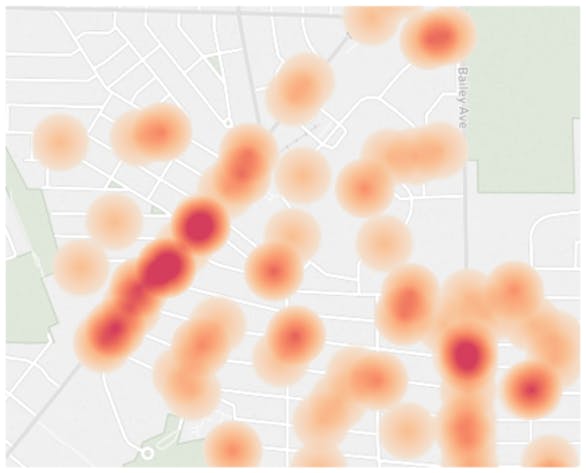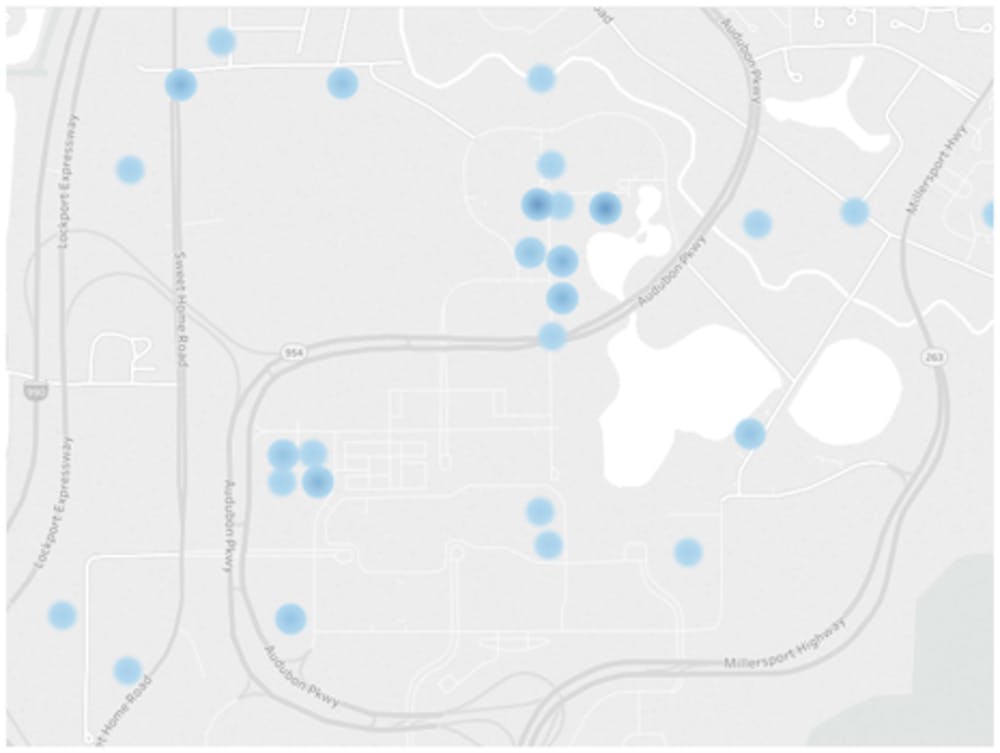Reported sexual offenses in the South Campus area reached a five-year high in 2018, but data doesn’t tell the complete story, according to UB officials.
The Spectrum analyzed roughly 2,800 sexual offense reports from Jan. 1, 2011 to Feb. 7, 2019 in the Buffalo/Amherst/UB area and found increases in reports since January 2018.
Reported offenses near South Campus increased from 18 in 2017 to 28 in 2018. These numbers are alarming to students at first but UB officials said the numbers may suggest an increased willingness to report, rather than an increase in the number of sexual offenses.
Data shows most people report offenses at UB from the residence halls, according to University Police. Thirty-six reports since 2011 came from on-campus residence halls, whereas the rest of the reports (11) came from places such as the Student Union and Lockwood Library.
UPD received 10 overall reports last year –– the most since 2012. There was a slight increase in reports since 2016, but the numbers don’t stray from the average number of reports per year.
“While each and every incident is a serious matter, statistically speaking, these numbers are too small to determine a significant trend in the crime rate,” said Chris Bartolomei, UPD’s chief of police. “I do believe that we have seen some increase in reporting over the years, which is a positive trend.”
Police reported 23 sexual offenses between the Main Street/Lasalle Avenue and Main Street/Winspear Avenue intersections. Most offenses in the South Campus area between 2011 and Feb. 7 were on Custer Street, Winspear Avenue, Rounds Avenue (off Bailey Avenue) and Lisbon Avenue, according to Buffalo Police reports.
The first block of Custer Street near South Campus is one of the most reported-from locations since 2011. Citywide data shows eight different reports at the location. This is the same amount of on-campus reports that UPD received in 2015.
Bartolomei said the location is out of UPD’s legal scope, but the department would assist with any Buffalo Police investigations if they led to Title IX/student conduct proceedings. UB has one active Title IX investigation regarding a sexual assault in 2016, according to the Chronicle of Higher Education. UPD filed 10 reports in 2018, whereas Buffalo Police filed roughly 300 reports every year since 2011.
Overall, local police mostly filed reports from area hospitals (with 34 reports at Erie County Medical Center), police departments (10 at Amherst Police Station) and popular city and nightlife areas since 2011. Twenty-seven reports came from the 1 block of Franklin Street in downtown Buffalo, data shows. Fourteen reports came from the 600 block of Main Street near Shea’s Performing Arts Center since 2011.

South Campus sexual offense data (with proximity-based exclusions), Jan. 1, 2011 through Feb. 7, 2019. Data courtesy of Open Data Buffalo, Amherst Police and University Police.
Bartolomei said interpreting police dispatch reports “can be tricky.”
“Often, you need to read through the entire report to determine time/location-related information,” Bartolomei said. “Almost every police report begins with a phone call to the dispatch center. Those recorded as being taken at the police station [are] sometimes because the person reporting the incident is more comfortable coming to the station than having the police come to their location.”
Anna Sotelo-Peryea, UB Health Promotion’s assistant director and violence prevention coordinator, said students have become more willing to report sexual offenses.
“We really can’t rely on police reports to give us the whole picture, given that sexual assaults have long been considered the most underreported crime,” Sotelo-Peryea said. “If you look back, you’ll see reports to police are on an upward trend. … [But] balanced against sexual assaults reported through anonymous surveys, we see an increase in police reports alongside decreasing or relatively unchanging rates of sexual violence.”
She said sexual assault victims typically know their abuser, “especially” in assaults among college students.
“It’s less about dark alleys and stranger danger, and more about casual patterns of disrespect,” Sotelo-Peryea said. “[It’s shown by people] not caring if their actions are making someone uncomfortable, trespassing on someone’s body in a crowded party or dance floor [or] pushing someone to drink more.”
Bartolomei said anonymous and third-party reports often provide UPD with incomplete information.
“What I would very much like for students to know is that our sex offense reporting procedures are centered on the needs and desires of the person reporting the incident,” Bartolomei said.
“They choose what options will be considered: whether it leads to a criminal investigation (if applicable), student conduct or Title IX hearing, or none of those options. People can speak directly to an officer while still remaining anonymous, and if they choose to identify themselves, we will do everything possible to maintain confidentiality.”
Bartolomei said the department hopes to remove “any apprehension people may have about speaking to the police” and sex offense investigators will inform students of “all the options and resources available to them.”
Sotelo-Peryea compiled data from the 2016 National College Health Assessment and found the impacts of sexual violence go beyond physical trauma, she said. Students who said they experienced sexual violence reported at least 30 percent higher rates of feelings of hopelessness, loneliness, sadness and overwhelming anxiety and anger than those who said they have not experienced sexual violence, according to the assessment.
Eight percent of students who said they experienced sexual violence reported attempted suicide and 23 percent experienced suicidal thoughts, according to NCHA.
Sotelo-Peryea said sexual assault can leave victims feeling vulnerable and alone, despite affecting nearly everyone.
“It’s still such an isolating experience, and I think trying to move beyond that is really where we need to be,” Sotelo-Peryea said. “Understanding that you're not in this alone, you're not the only person that's experienced [this and] there's not something uniquely vulnerable or flawed or faulty that's caused this to happen.”
If you or someone you know fear or have experienced sexual assault, there are a number of local resources. Students can make an anonymous report on UB’s website, through the Office of Equity, Diversity and Inclusion (716-645-2266), Crisis Services of Erie County (716-834-3131) and UPD (716-645-2222). For off-campus emergencies call 911, Amherst PD (716-689-1311), Buffalo PD (716-851-4444) or the New York State police 24/7 sexual assault hotline for college campuses (1-844-845-7269).
Benjamin Blanchet and Jacklyn Walters are editors and can be reached at news@ubspectrum.com and on Twitter at @BenjaminUBSpec and @JacklynUBSpec.

Benjamin Blanchet is the senior engagement editor for The Spectrum. His words have been seen in The Buffalo News (Gusto) and The Sun newspapers of Western New York. Loves cryptoquip and double-doubles.

Jacklyn Walters is a senior communication major and The Spectrum's managing editor. She enjoys bringing up politics at the dinner table and seeing dogs on campus.





